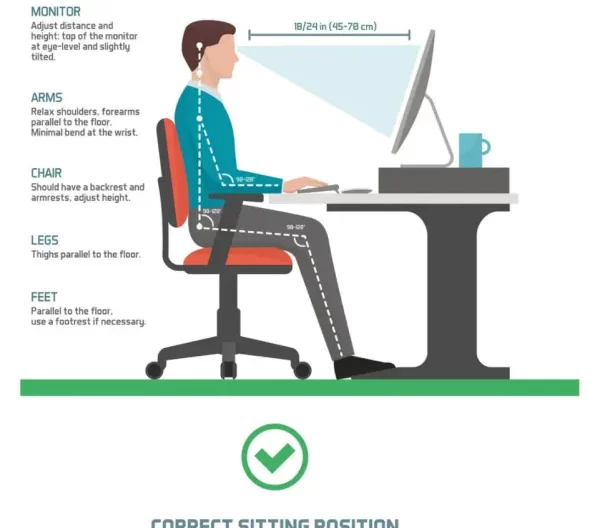
Table of Contents
In the modern workspace, back pain has become a prevalent issue, affecting a significant portion of the workforce. This article delves into practical strategies to alleviate and prevent back pain, ensuring a more comfortable and productive work experience.
The Plight of Desk Workers
Millions of workers globally operate from desks, a setup that often leads to back pain. Poor sitting posture, inadequate chairs, and the lack of breaks contribute significantly to this discomfort. The World Health Organization reports that over 600 million people suffer from temporary or chronic back problems, a staggering figure that highlights the scale of this issue. The modern office environment, while efficient, does not always cater to the physical well-being of its occupants, with prolonged sitting and poor ergonomic setups being major culprits in the rise of back-related complaints.
Ergonomic Solutions at the Workplace
In response to the growing concern over back health, numerous practical tools have been introduced to the workplace. A standing desk stands out among these, offering a dynamic way to work while reducing the strain on the back. The versatility of a standing desk allows for alternating between sitting and standing, promoting better posture and reducing the risks associated with prolonged sitting. Other helpful tools include ergonomic chairs that support the natural curve of the spine, keyboard trays to maintain a neutral wrist position, and footrests to ensure proper leg alignment.
Optimizing Your Standing Desk for Ergonomic Excellence
Setting the standing desk to the correct height is fundamental for ergonomic efficiency. The desk should be adjusted so that your elbows are at a 90-degree angle when typing. This position reduces strain on your arms and shoulders, ensuring a comfortable posture.
Position the monitor at eye level to avoid neck strain. The top of the screen should be at or slightly below eye level, and about an arm’s length away. This setup helps in maintaining a natural head and neck position, preventing fatigue and discomfort.
Place the keyboard and mouse close to each other and within easy reach. This arrangement minimizes unnecessary stretching and twisting of the arms, reducing the risk of strain injuries. The mouse should be at the same level as the keyboard, allowing for a relaxed and neutral wrist position.
Maximizing Comfort and Efficiency
Organize commonly used items within arm’s reach. This practice conserves energy and minimizes repetitive reaching or twisting movements. Accessories like document holders or phone stands should be positioned to avoid excessive head movement, thereby optimizing workflow and comfort.
Consider using an anti-fatigue mat and wearing supportive shoes while standing. These reduce pressure on your feet and encourage subtle movements, improving circulation and reducing fatigue. Periodically shifting your weight from one foot to the other also helps in maintaining balance and comfort.
Striking the Perfect Balance: Mastering the Sit-Stand Work Rhytm
Research into the ideal sitting duration has been extensive. A study conducted by a renowned university suggests that prolonged sitting, exceeding six hours a day, significantly increases the risk of back pain. This research emphasizes the importance of taking regular breaks and alternating between sitting and standing.
The study highlights how continuous sitting can lead to spinal compression and muscle stiffness, factors contributing to back discomfort. As a preventive measure, it’s recommended to take short breaks every hour, even if it’s just for a few minutes, to stretch and move around. This not only alleviates pressure on the back but also enhances overall productivity and mental alertness.
Integrating the Pomodoro Technique for Ergonomic Work Transitions
The Pomodoro Technique is a time management method involving intervals of focused work followed by short breaks. Typically, this involves 25 minutes of concentrated work, then a 5-minute break. This approach not only boosts productivity but also offers an opportunity to change working positions.
Start with a 25-minute work session while standing. This helps in maintaining an active posture and encourages better circulation. As the timer goes off, take your 5-minute break and switch to a seated position. This short break allows you to rest your legs and relax your back muscles.
During the break, engage in light stretching or walking. These movements help in reducing muscle fatigue and stiffness. Regularly switching between sitting and standing aligns with the natural rhythm of the Pomodoro intervals, making it a seamless habit.
Employer’s Responsibility for Ergonomic Workstations
Whether an employer must provide an ergonomic workstation varies by law and company policy. In many regions, occupational health and safety regulations encourage or require employers to ensure a safe and healthy working environment, which can include ergonomic furniture. Highlighting the benefits to the employer can be a persuasive approach. Ergonomic furniture like standing desks reduces employee absenteeism by preventing work-related musculoskeletal disorders.
Convincing Your Employer
Approaching your employer with a well-reasoned argument can be effective. Start by presenting research on the health benefits of ergonomic furniture, emphasizing reduced risk of chronic pain and improved overall health. Point out the long-term cost savings, as healthier employees can mean lower healthcare costs and fewer sick days. Share success stories from other companies that have implemented ergonomic solutions. Proposing a trial period for ergonomic furniture can also be a less daunting approach for an employer.
Easy Exercises for Back Health
A simple yet effective exercise is the upper back stretch. Stand or sit straight, extend your arms forward, and clasp your hands together. Gently push your hands forward while rounding your back, feeling the stretch in your upper back. Hold this position for a few seconds before releasing. This exercise helps in relieving tension in the upper back and shoulders, areas often strained from poor posture at a desk.
Lower Back Flexibility
For the lower back, try the seated spinal twist. Sit on a chair with your feet flat on the ground. Twist your torso to the right, holding the back of the chair for support, and hold for a few seconds. Repeat on the left side. This exercise enhances spinal mobility and relieves stiffness in the lower back.
Strengthening the Core
Core strength is vital for back health. A simple exercise is the pelvic tilt. Lie on your back with your knees bent and feet flat on the floor. Tighten your abdominal muscles and gently arch your lower back, pressing it into the floor. Hold for a few seconds, then relax. This exercise strengthens the core muscles, providing better support for the back.




